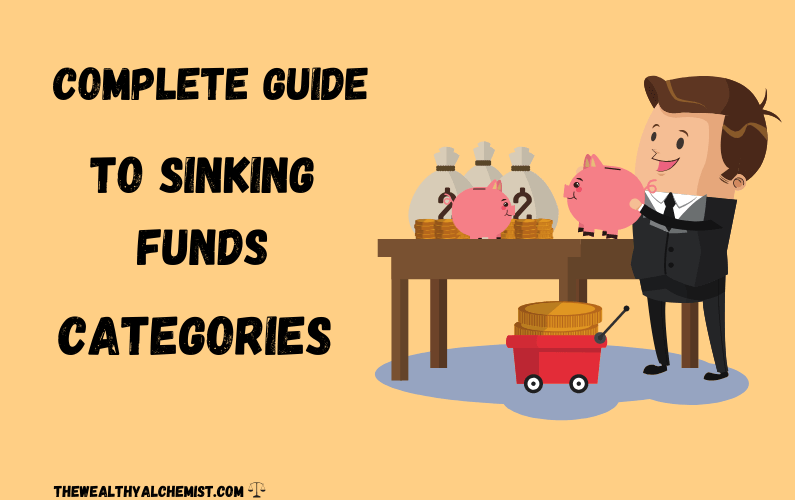
If you’re tired of watching your savings account get eaten up by unplanned expenses and impulse purchase, then sinking funds categories can help!
I know this because sinking funds categories helped me organize my own finances.
It used to be impossible for me to save up the money for a vacation. Not because I’m a slow saver, but because every time my savings account grew, I would get slammed with some unexpected expense.
One time, I had to change all my tires. Another time, I to pay for a trip to the doctor.
The point is, there’s always something…and that something keeps pushing your savings closer to zero despite all your hard work…talk about a total bummer. ![]()
It wasn’t until I started using sinking funds that I was able to actually use the money for the things I planned.
That’s what sinking funds did for me, and that’s what they can do for you!
In the next few minutes, we’re going show you what sinking funds are, how sinking funds categories work, and which sinking fund categories you should consider using to get your finances under control.
Let’s do it!
Related Post: 13 Budget Items You Never Want to Forget.
First off, what’s a sinking fund exactly?
A sinking fund is a sum of money you build little by little for a specific future purpose. Things like holiday shopping, family vacations or home additions are all common reasons to create a sinking fund.
There are three important things to keep in mind when it comes to sinking funds.
(1) Sinking funds are always for a specific reason. If you decide to create a sinking fund for holiday shopping and end up using it to buy groceries or for car repairs, the fund has failed its purpose.
(2) Sinking funds have a goal amount. When starting your sinking fund, you should have an idea of how much you’ll need. Whether it’s a vacation, or down payment on a home, you need to figure out how much you’ll need.
(3) Sinking funds need to be fully funded by a certain date. A Christmas shopping sinking fund has to be funded by, of course, Christmas.
Sinking funds for vacations and anything else should also have a due date. The date will help you figure out how much you need to save every month to meet your target.
With your reason, goal amount and due date set, you’ll have a pretty good idea of exactly how much you’ll need to set aside each month to complete your sinking fund.
Sinking funds vs. Savings accounts vs Emergency funds
Understanding the difference between sinking funds, emergency funds, and savings accounts is crucual. In fact, it can save you a world of frustration.
But let me back up for a moment.
Before, when I was trying to saving money for a vacation, I kept having problems because I was wanting to create a sinking fund, but I kept using it as an emergency fund.
It wasn’t until I understood the difference between the two and kept the two separate that I was able to solve my problem.
So, what’s the difference between these three money pools?
Sinking Funds
- Sinking funds are created for a specific purpose (i.e. purchases, debt payoffs),
- The amount of money needed for the fund is determined by the price tag of what you want to buy
- The sinking fund has to be complete by a certain date
Emergency Funds
Emergency funds, on the other hand, are created for situations that you can’t really anticipate (i.e. job loss, medical emergency, etc.).
- They don’t have due dates, but the faster you can build your emergency fund, the better!
- Emergency funds have target amounts, which are determined by you and your best judgement (not by a price tag).
- The fund doesn’t have a specific purpose. It just generally covers what you consider to be emergencies.
- Cash from your emergency funds should be easy to get (a.k.a. liquid)
Saving Accounts
- Unlike emergency funds and sinking funds, savings accounts don’t have target amounts or due dates
- The intent behind savings is generally investment and future use.
- Since savings aren’t meant to be spent, they don’t have to be as liquid as emergency funds.
Related Post: How to Create a Budget to Succed Financially.
How Do Sinking Funds Work? An Example…
Now that we know the three characteristics of a sinking fund, let’s go through an example of how they work.
Let’s say I want to go on my vacation to Disney World and I create a sinking fund category for it. ![]()
Next, how much should go in the sinking fund?
To figure that out, I do a little online research.
I look up the costs of the tickets to get inside the park, hotel, gas, food, etc. and I figure out that I need $1,000 (a totally invented number by the way). Now I have my target amount.
And let’s say I want to go 5 months from now. So now I have my due date.
From there it should be pretty simple. I have to save $200 each month for the next 5 months in order to complete the sinking fund.
The hard part is actually doing it!

Where To Keep Your Sinking Fund Money?
When it comes where to keep your money, you’ve got three main options.
(1) Keep it in cash
(2) Combine the cash for all your sinking funds into one account
(3) Create a separate bank account for each sinking fund
Naturally, each of these options comes with a list of pros and cons.
The Cash Option
Pros:
- You can easily keep your sinking fund cash organized and separated in envelopes.
Cons:
- The cash is easy to grab and spend on other things
- Cash can easily be stolen
The One Account Option
Pros:
- If your account balance is high enough, you may earn some interest. (Check out the accounts offered by CIT Bank.)
- Avoid extra fees by limiting your sinking funds to one account
Cons:
- Difficulty keeping track of how much money is allocated to each sinking fund
The Multiple Account Option
Pros:
- Easy to keep track of how much is allocated to each sinking fund
- Easy to recall your goals with individual accounts named after each goal
Cons:
- Your bank may charge additional fees for multiple accounts
- May be hard to meet minimum balance requirements for multiple accounts
Don’t feel you have to limit yourself to one option either. Maybe you have a short term sinking fund that you want to keep in cash and a long-term fund you want to save in the bank.
If you choose to go the bank route, keep in mind that credit unions tend to have lower fees than banks, so credit unions may be a good option if you’re looking to open multiple accounts.
Also, online banks like CIT Bank can offer higher interest rates than physical banks, so if you’re looking to earn more interest, they may have the best accounts for sinking funds.
However you choose to save your money isn’t super important, as long as it works for you!
How Many sinking funds should you create?
Create as many sinking funds as you need!
Just keep in mind that the longer your sinking funds list is, the harder it will be to fully fund all of them! So if you want to do something fast, you may want to limit your sinking fund categories to just a handful.
If, on the other hand, you’re not in a rush to complete your sinking funds, then there’s no problem creating more.
When figuring out how many sinking funds categories you need, it might help to know that they all fit into three broad types.
(1) Large purchases you want to make (vacation, downpayment on a house or car, etc.)
(2) Expenses you know will appear, and can reasonably estimate, but you just don’t know exactly when (i.e. car repairs, etc.) (You don’t have to raid your emergency fund if you prepare a sinking fund in advance.)
(3) Annual expenses (i.e. memberships, insurance premiums etc.)
These three broad sinking fund categoies should cover any type of sinking fund you’ll need, and this way you’ll able to keep your emergency fund intact. You also won’t have to swipe your credit card to pay for items that you didn’t budget for.
Related Post: Who Needs a Budget? Everyone.
Common Sinking Funds Categories
1) Car Repair
Even if you decide to buy a Tesla, you know that eventually it’ll need some maintenance. It could just be routine maintenece like oil changes or new filters. Saving the money for it now will save your budget tomorrow.
2) Pet costs
Pet costs are one of the most easily forgotten expenses out there. Remeber that Fluffy will need vet visits, occassional grooming, food, treats, and maybe traveling supplies as well.
3) Birthdays
We all love to celebrate special days with family and friends by buying them something special for birthdays,weddings or anniversaries. But what we don’t love is having to come up with a gift when there’s nothing in the bank.
This sinking fund category is a must.
4) Home repairs/improvements
Home repairs can cost you a pretty penny depending on how extensive they are. Whether it’s changing the windows, repairing the roof, the water pump, water tank, or anything else, you need a sinking fund.
5) Medical
You never know when you’re going to need to pay for medical expenses. Whether you need to pay for medical insurance deductibles or just some medicine and supplies from the pharmacy.
Either way, creating a sinking fund category for medical expenses is a great idea.
6) Clothing
During the year you’ll no doubt go have to go shopping for new clothes and outfits. A sinking fund just for clothes will help make sure you have money for clothes when you need them and will keep you from feeling guilty about buying outfits you want.
7) Memberships
It’s easy to forget annual membership payments, because they only come around once a year. And if you let your membership fees sneak up on you, you may have to pull the money from you emergency fund to cover the cost.
Setting up your memberships sinking fund now can help you avoid this.
8) Down payments
If you plan on buying a car or house or anything that requires a down payment, you definitely need a sinking fund category for this!
By creating a sinking fund category specifically for you down payments, you’ll find it easier to stay on track and reach your goal.
9) Travel

A classic sinking fund example is the travel fund. It’s also one of the most important.
I can’t tell you how many times I, and people I know, have saved money for a vacation only to end up spending it on repairs and unexpected emergencies.
Do yourself a favor and create a sinking fund just for your trips.
10) Appliances/Furniture
Broken appliances and furniture may seem like an expense for your emergency fund. That may be true, but you know that household items wear down and break eventually. So, why not create a sinking fund for it?
Or maybe you just want a nicer couch or refrigerator. If that’s the case don’t sign up for a store card or buy it with your Visa. Instead, create a sinking fund and avoid the interest payments.
11) Insurance
Some insurance premiums are paid once a year. Car insurance, life insurance, renters insurance, etc. If this is the case for you, a sinking fund can be useful here too.
12. Christmas
Christmas it’s one of the most important family events during the year, you end up buying all kinds of gifts for friends and relatives. You spend a lot of time and energy on food. And you may even end up traveling.
This means you definitely need a Christmas/Holiday fund. To read more about this specific sinking fund check out Dave Ramsey sinking fund Christmas article.
Other sinking funds categories you might consider
- Property taxes
- Giving
- Kid’s activity
- Income taxes
- Allowance
Related post: How to become a money-saving machine.
Final Thoughts
Sinking funds are a great way to prevent you from messing up your budget and keep you on track to accomplish your goals.
Keep in mind that sinking funds, while similar to emergency funds, are different! And it’s important to your financial success that keep your sinking funds categories and your emergency fund separate!
If you’ve ever used sinking funds categories before, let us know how it worked out for you.
Cheers!

Idalmis
Latest posts by Idalmis (see all)
- Why Is Budgeting Important? 12 Best Reasons to Start Budgeting Today! - October 6, 2020
- How to be Frugal With Groceries. Must Try Tips! - September 15, 2020
- Is Skillshare Worth It? Best 2020 Review - August 31, 2020

